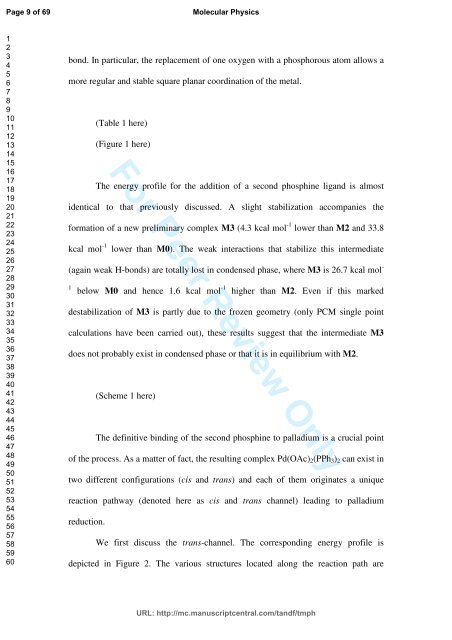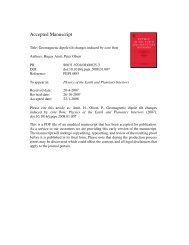For Peer Review Only - TARA
For Peer Review Only - TARA
For Peer Review Only - TARA
You also want an ePaper? Increase the reach of your titles
YUMPU automatically turns print PDFs into web optimized ePapers that Google loves.
Page 9 of 69<br />
Molecular Physics<br />
1<br />
2<br />
3<br />
4<br />
5<br />
6<br />
7<br />
8<br />
9<br />
10<br />
11<br />
12<br />
13<br />
14<br />
15<br />
16<br />
17<br />
18<br />
19<br />
20<br />
21<br />
22<br />
23<br />
24<br />
25<br />
26<br />
27<br />
28<br />
29<br />
30<br />
31<br />
32<br />
33<br />
34<br />
35<br />
36<br />
37<br />
38<br />
39<br />
40<br />
41<br />
42<br />
43<br />
44<br />
45<br />
46<br />
47<br />
48<br />
49<br />
50<br />
51<br />
52<br />
53<br />
54<br />
55<br />
56<br />
57<br />
58<br />
59<br />
60<br />
bond. In particular, the replacement of one oxygen with a phosphorous atom allows a<br />
more regular and stable square planar coordination of the metal.<br />
(Table 1 here)<br />
(Figure 1 here)<br />
The energy profile for the addition of a second phosphine ligand is almost<br />
identical to that previously discussed. A slight stabilization accompanies the<br />
formation of a new preliminary complex M3 (4.3 kcal mol -1 lower than M2 and 33.8<br />
kcal mol -1 lower than M0). The weak interactions that stabilize this intermediate<br />
(again weak H-bonds) are totally lost in condensed phase, where M3 is 26.7 kcal mol -<br />
1 below M0 and hence 1.6 kcal mol -1 higher than M2. Even if this marked<br />
destabilization of M3 is partly due to the frozen geometry (only PCM single point<br />
calculations have been carried out), these results suggest that the intermediate M3<br />
does not probably exist in condensed phase or that it is in equilibrium with M2.<br />
(Scheme 1 here)<br />
The definitive binding of the second phosphine to palladium is a crucial point<br />
<strong>For</strong> <strong>Peer</strong> <strong>Review</strong> <strong>Only</strong><br />
of the process. As a matter of fact, the resulting complex Pd(OAc) 2 (PPh 3 ) 2 can exist in<br />
two different configurations (cis and trans) and each of them originates a unique<br />
reaction pathway (denoted here as cis and trans channel) leading to palladium<br />
reduction.<br />
We first discuss the trans-channel. The corresponding energy profile is<br />
depicted in Figure 2. The various structures located along the reaction path are<br />
URL: http://mc.manuscriptcentral.com/tandf/tmph
















